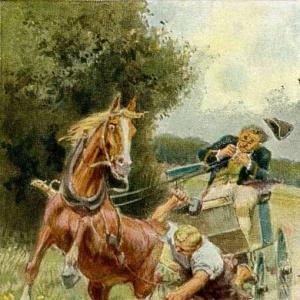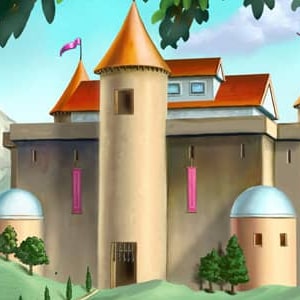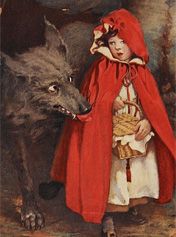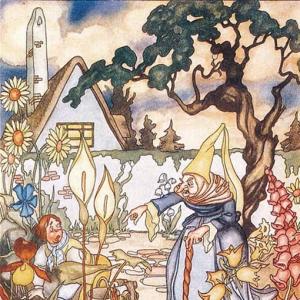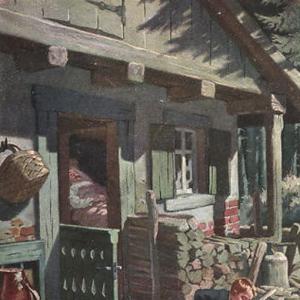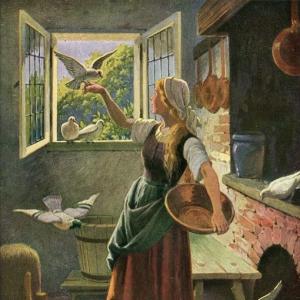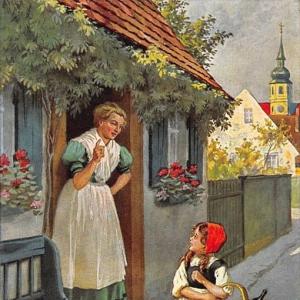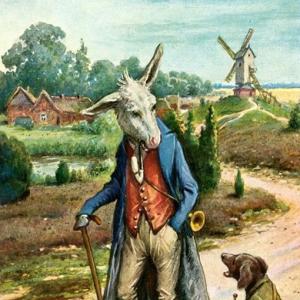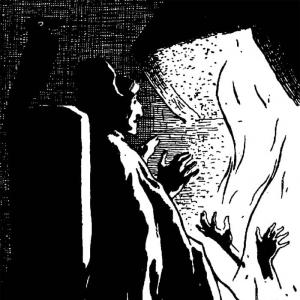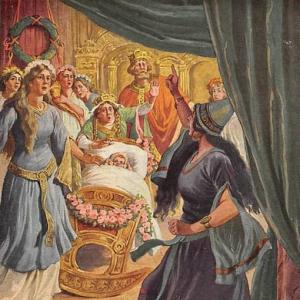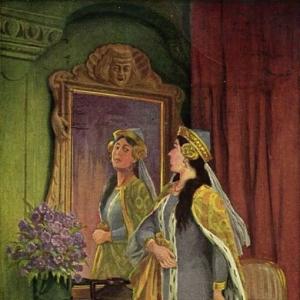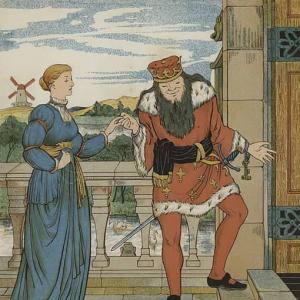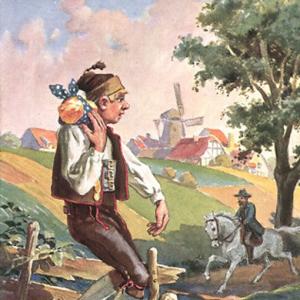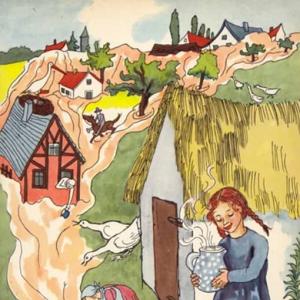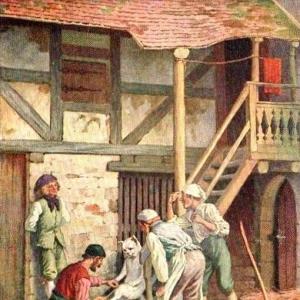Reading time: 12 min
A woman was going about the unenclosed land with her daughter and her step-daughter cutting fodder, when the Lord came walking towards them in the form of a poor man, and asked, „Which is the way into the village?“ – „If you want to know,“ said the mother, „seek it for yourself,“ and the daughter added, „If you are afraid you will not find it, take a guide with you.“ But the step-daughter said, „Poor man, I will take you there, come with me.“ Then God was angry with the mother and daughter, and turned his back on them, and wished that they should become as black as night and as ugly as sin. To the poor step-daughter, however, God was gracious, and went with her, and when they were near the village, he said a blessing over her, and spake, „Choose three things for thyself, and I will grant them to thee.“ Then said the maiden, „I should like to be as beautiful and fair as the sun,“ and instantly she was white and fair as day. „Then I should like to have a purse of money which would never grow empty.“ That the Lord gave her also, but he said, „Do not forget what is best of all.“ Said she, „For my third wish, I desire, after my death, to inhabit the eternal kingdom of Heaven.“ That also was granted unto her, and then the Lord left her. When the step-mother came home with her daughter, and they saw that they were both as black as coal and ugly, but that the step-daughter was white and beautiful, wickedness increased still more in their hearts, and they thought of nothing else but how they could do her an injury. The step-daughter, however, had a brother called Reginer, whom she loved much, and she told him all that had happened. Once on a time Reginer said to her, „Dear sister, I will take thy likeness, that I may continually see thee before mine eyes, for my love for thee is so great that I should like always to look at thee.“ Then she answered, „But, I pray thee, let no one see the picture.“ So he painted his sister and hung up the picture in his room; he, however, dwelt in the King’s palace, for he was his coachman. Every day he went and stood before the picture, and thanked God for the happiness of having such a dear sister. Now it happened that the King whom he served, had just lost his wife, who had been so beautiful that no one could be found to compare with her, and on this account the King was in deep grief. The attendants about the court, however, remarked that the coachman stood daily before this beautiful picture, and they were jealous of him, so they informed the King. Then the latter ordered the picture to be brought to him, and when he saw that it was like his lost wife in every respect, except that it was still more beautiful, he fell mortally in love with it. He caused the coachman to be brought before him, and asked whom the portrait represented? The coachman said it was his sister, so the King resolved to take no one but her as his wife, and gave him a carriage and horses and splendid garments of cloth of gold, and sent him forth to fetch his chosen bride. When Reginer came on this errand, his sister was glad, but the black maiden was jealous of her good fortune, and grew angry above all measure, and said to her mother, „Of what use are all your arts to us now when you cannot procure such a piece of luck for me?“ – „Be quiet,“ said the old woman, „I will soon divert it to you,“ and by her arts of witchcraft, she so troubled the eyes of the coachman that he was half-blind, and she stopped the ears of the white maiden so that she was half-deaf. Then they got into the carriage, first the bride in her noble royal apparel, then the step-mother with her daughter, and Reginer sat on the box to drive. When they had been on the way for some time the coachman cried,
„Cover thee well, my sister dear,
That the rain may not wet thee,
That the wind may not load thee with dust,
That thou may’st be fair and beautiful
When thou appearest before the King.“
The bride asked, „What is my dear brother saying?“ – „Ah,“ said the old woman, „he says that you ought to take off your golden dress and give it to your sister.“ Then she took it off, and put it on the black maiden, who gave her in exchange for it a shabby grey gown. They drove onwards, and a short time afterwards, the brother again cried,
„Cover thee well, my sister dear,
That the rain may not wet thee,
That the wind may not load thee with dust,
That thou may’st be fair and beautiful
When thou appearest before the King.“
The bride asked, „What is my dear brother saying?“ – „Ah,“ said the old woman, „he says that you ought to take off your golden hood and give it to your sister.“ So she took off the hood and put it on her sister, and sat with her own head uncovered. And they drove on farther. After a while, the brother once more cried,
„Cover thee well, my sister dear,
That the rain may not wet thee,
That the wind may not load thee with dust,
That thou may’st be fair and beautiful
When thou appearest before the King.“
The bride asked, „What is my dear brother saying?“ – „Ah,“ said the old woman, „he says you must look out of the carriage.“ They were, however, just on a bridge, which crossed deep water. When the bride stood up and leant forward out of the carriage, they both pushed her out, and she fell into the middle of the water. At the same moment that she sank, a snow-white duck arose out of the mirror-smooth water, and swam down the river. The brother had observed nothing of it, and drove the carriage on until they reached the court. Then he took the black maiden to the King as his sister, and thought she really was so, because his eyes were dim, and he saw the golden garments glittering. When the King saw the boundless ugliness of his intended bride, he was very angry, and ordered the coachman to be thrown into a pit which was full of adders and nests of snakes. The old witch, however, knew so well how to flatter the King and deceive his eyes by her arts, that he kept her and her daughter until she appeared quite endurable to him, and he really married her.
One evening when the black bride was sitting on the King’s knee, a white duck came swimming up the gutter to the kitchen, and said to the kitchen-boy, „Boy, light a fire, that I may warm my feathers.“ The kitchen-boy did it, and lighted a fire on the hearth. Then came the duck and sat down by it, and shook herself and smoothed her feathers to rights with her bill. While she was thus sitting and enjoying herself, she asked, „What is my brother Reginer doing?“ The scullery-boy replied, „He is imprisoned in the pit with adders and with snakes.“ Then she asked, „What is the black witch doing in the house?“ The boy answered, „She is loved by the King and happy.“
„May God have mercy on him,“ said the duck, and swam forth by the sink.
The next night she came again and put the same questions, and the third night also. Then the kitchen-boy could bear it no longer, and went to the King and discovered all to him. The King, however, wanted to see it for himself, and next evening went thither, and when the duck thrust her head in through the sink, he took his sword and cut through her neck, and suddenly she changed into a most beautiful maiden, exactly like the picture, which her brother had made of her. The King was full of joy, and as she stood there quite wet, he caused splendid apparel to be brought and had her clothed in it. Then she told how she had been betrayed by cunning and falsehood, and at last thrown down into the water, and her first request was that her brother should be brought forth from the pit of snakes, and when the King had fulfilled this request, he went into the chamber where the old witch was, and asked, What does she deserve who does this and that? and related what had happened. Then was she so blinded that she was aware of nothing and said, „She deserves to be stripped naked, and put into a barrel with nails, and that a horse should be harnessed to the barrel, and the horse sent all over the world.“ All of which was done to her, and to her black daughter. But the King married the white and beautiful bride, and rewarded her faithful brother, and made him a rich and distinguished man.
 Learn languages. Double-tap on a word.Learn languages in context with Childstories.org and Deepl.com.
Learn languages. Double-tap on a word.Learn languages in context with Childstories.org and Deepl.com.Backgrounds
Interpretations
Adaptions
Summary
Linguistics
„The White Bride and the Black One“ is a German fairy tale collected by the Brothers Grimm, who were Jacob and Wilhelm Grimm. The tale is included in their famous anthology, „Grimm’s Fairy Tales“ (originally titled „Kinder- und Hausmärchen“), first published in 1812. The Brothers Grimm were German linguists, cultural researchers, and authors who gathered and recorded oral folklore during the early 19th century as a part of their efforts to preserve and study Germanic culture and history.
The Grimms‘ collection of fairy tales became immensely popular and had a significant impact on the development of the modern fairy tale genre. Their works have been translated into more than 100 languages and have been adapted into various media, including theater, film, and television.
The tales in the collection often feature magical elements, moral lessons, and archetypal characters such as wicked stepmothers, noble heroes, and enchanted creatures. „The White Bride and the Black One“ is a prime example of the themes and motifs found in many Grimm fairy tales, with its focus on the consequences of good and evil actions, the importance of kindness and humility, and the transformative power of love.
The story is rooted in the oral storytelling tradition, which means that it likely has various versions and interpretations. The Brothers Grimm’s version is just one of the many possible ways this story has been told throughout history.
„The White Bride and the Black One“ can be interpreted in several ways, focusing on themes such as the consequences of one’s actions, the importance of kindness and humility, and the transformative power of love and compassion.
Consequences of one’s actions: The story highlights the importance of treating others with kindness and respect. The mother and her daughter are punished for their rude behavior towards the Lord, while the step-daughter is rewarded for her kindness. This theme is reinforced when the step-mother and half-sister plot against the step-daughter, ultimately leading to their own punishment.
Importance of kindness and humility: The step-daughter’s kindness, humility, and compassion set her apart from her family members. Her good nature ultimately brings her blessings, love, and protection. This theme serves as a reminder to readers to cultivate and value these qualities in their own lives.
Transformative power of love and compassion: The step-daughter’s transformation from a white duck back into a beautiful maiden can be seen as a metaphor for the power of love and compassion to heal and restore. The King’s love for the step-daughter and his determination to seek justice for her ultimately bring about her transformation, saving her from her cursed state.
The dangers of envy and jealousy: The story also warns against the destructive power of envy and jealousy, as displayed by the mother and her daughter. Their jealousy towards the step-daughter leads them to plot against her, which ultimately results in their own downfall.
Deceptive appearances: Another theme in the story is the importance of not judging someone based on their appearance. The step-mother and her daughter use deceit to present themselves as beautiful and virtuous, but their true nature is revealed in the end. Similarly, the step-daughter’s transformation from a duck to a beautiful maiden underscores the idea that true beauty and worth lie within a person’s character, not their external appearance.
Overall, „The White Bride and the Black One“ offers moral lessons about kindness, humility, and the consequences of one’s actions, while also exploring themes of love, transformation, and the deceptive nature of appearances.
„The White Bride and the Black One“ (also known as „The Singing, Springing Lark“) from Brothers Grimm has been adapted into various forms of media over the years, including:
Operas: The tale has been adapted into several operas, including „The Singing, Springing Lark“ by English composer Ralph Vaughan Williams and „Die singende, klingende Baum“ by Austrian composer Ernst Toch.
Films: The tale has been adapted into several films, including the Soviet film „The Singing, Ringing Tree“ in 1957, which was later dubbed in English and shown on British television.
Plays: The tale has been adapted into several stage productions, including „The White Bride and the Black One“ by the Royal Shakespeare Company in 1982.
Children’s books: The tale has been adapted into several children’s books, including „The Singing, Springing Lark“ by German author Max Bolliger.
Musicals: The tale has been adapted into several musicals, including „The White Bride and the Black One“ by American composer Richard Rodgers.
Overall, „The White Bride and the Black One“ is a popular and enduring fairy tale that continues to inspire adaptations in various forms of media.
„The White Bride and the Black One“ is a fairy tale by Brothers Grimm about a woman, her daughter, and her step-daughter who encounter the Lord in the form of a poor man. The mother and her daughter treat the Lord rudely, while the step-daughter treats him kindly, resulting in blessings for the step-daughter and a curse for the mother and her daughter. The step-daughter becomes beautiful and wealthy and is promised a place in Heaven after her death. Her step-mother and half-sister, however, grow jealous and plot against her.
The step-daughter has a brother, Reginer, who paints a portrait of her. The King, mourning his late wife, falls in love with the portrait and sends Reginer to bring his sister to be his bride. The step-mother uses witchcraft to confuse Reginer and deceive the step-daughter, stealing her beautiful garments and replacing them with shabby ones. The step-mother and half-sister then push the step-daughter into a river, where she transforms into a white duck.
Reginer unknowingly takes his half-sister, dressed as the beautiful bride, to the King. The King is initially angered by her ugliness, but the step-mother’s witchcraft deceives him into marrying her. Reginer is imprisoned with snakes as punishment. Meanwhile, the step-daughter, as a duck, visits the palace three times, asking about her brother and the step-mother. The King eventually learns of the duck’s visits and kills the duck, which transforms back into the beautiful step-daughter.
The step-daughter reveals the truth, her brother is freed, and the King punishes the step-mother and half-sister by following the step-mother’s own suggested punishment: placing them in a barrel with nails and sending them off with a horse. The King marries the true white bride and rewards her brother, making him a rich and distinguished man.
The fairy tale „The White Bride and the Black One,“ collected by the Brothers Grimm, is a story that provides a rich ground for linguistic and thematic analysis. Here’s a linguistic analysis focusing on various aspects such as narrative structure, character dichotomy, use of language, and motifs:
Narrative Structure and Elements
Classic Folktale Structure:
Introduction and Setting: The story starts in a typical folktale manner, with a woman, her daughter, and step-daughter working on the land. This setting establishes the socio-economic background and relationships.
Intervention of the Supernatural: The introduction of the Lord (God) in disguise is a common motif, indicating the interference of the divine in human affairs based on moral actions.
Transformation and Reward: The step-daughter’s kindness is rewarded through divine intervention, a transformation that underscores her inner virtue with outer beauty.
Conflict: The envy and wickedness of the step-mother and her daughter introduce the central conflict. Their actions are driven by jealousy, a classic narrative element in fairy tales.
Resolution and Justice: The resolution follows the exposure of deceit and the restoration of the rightful order, punishing the wicked and rewarding the virtuous.
Character Dichotomy: The binary opposition between the „white“ and „black“ characters is heavily emphasized. „White“ symbolizes purity, kindness, and divine favor, while „black“ represents wickedness, deceit, and curse. This stark contrast is reinforced visually (through physical appearances) and morally, conforming to the conventional morality plays often found in folklore.
Language Use
Symbolism and Color Imagery
Colors play a significant symbolic role: white and black are not just physical descriptions but moral judgments. This use of color symbolism is prevalent in many Grimm tales.
Dialogue and Direct Speech: Dialogue is used to reveal character intentions. For instance, the direct speech of the step-mother and her daughter reflects their rude and dismissive nature. The step-daughter’s polite offer to guide the poor man (God) showcases her virtuous character.
Repetitive Structure: The tale employs repetitive structures, such as the poetic pleas by the brother to his sister, which are later misinterpreted by the step-mother to deceitful ends. Repetitive elements stress the thematic aspects and aid in memorability, a vital feature of oral traditions.
Motifs and Themes: The „duck“ motif is significant, often symbolizing transformation in folklore. Here, it links to themes of purity and renewal. The motif of testing character through divine or supernatural means is prevalent in the Grimm’s collection, emphasizing moral lessons.
Themes and Moral Lessons
Virtue versus Vice: At its core, the tale is a morality play contrasting the rewards of virtue with the consequences of vice. The step-daughter’s ultimate triumph and the punishment of her wicked relatives reinforce this.
Justice and Retribution: The narrative fulfills a sense of justice where good is ultimately rewarded, and evil is punished, reflecting societal norms and values of justice typical in fairy tales.
Social and Familial Dynamics: The story explores complex family dynamics involving favoritism and jealousy, common themes in fairy tales that reflect real social concerns.
Conclusion
The story of „The White Bride and the Black One“ employs linguistic elements archetypical of the Brothers Grimm’s fairy tales: binary oppositions, symbolic language, moral dichotomies, and supernatural justice. Through its use of simple yet powerful language, the tale conveys moral lessons about the virtues of kindness, the inevitability of justice, and the folly of envy and deceit.
Information for scientific analysis
Fairy tale statistics | Value |
|---|---|
| Number | KHM 135 |
| Aarne-Thompson-Uther-Index | ATU Typ 403A |
| Translations | DE, EN, DA, ES, FR, PT, FI, HU, IT, JA, NL, PL, RU, TR, VI, ZH |
| Readability Index by Björnsson | 37.1 |
| Flesch-Reading-Ease Index | 76.8 |
| Flesch–Kincaid Grade-Level | 8.7 |
| Gunning Fog Index | 11.5 |
| Coleman–Liau Index | 7.9 |
| SMOG Index | 9.2 |
| Automated Readability Index | 9.9 |
| Character Count | 8.189 |
| Letter Count | 6.291 |
| Sentence Count | 63 |
| Word Count | 1.560 |
| Average Words per Sentence | 24,76 |
| Words with more than 6 letters | 193 |
| Percentage of long words | 12.4% |
| Number of Syllables | 1.934 |
| Average Syllables per Word | 1,24 |
| Words with three Syllables | 67 |
| Percentage Words with three Syllables | 4.3% |
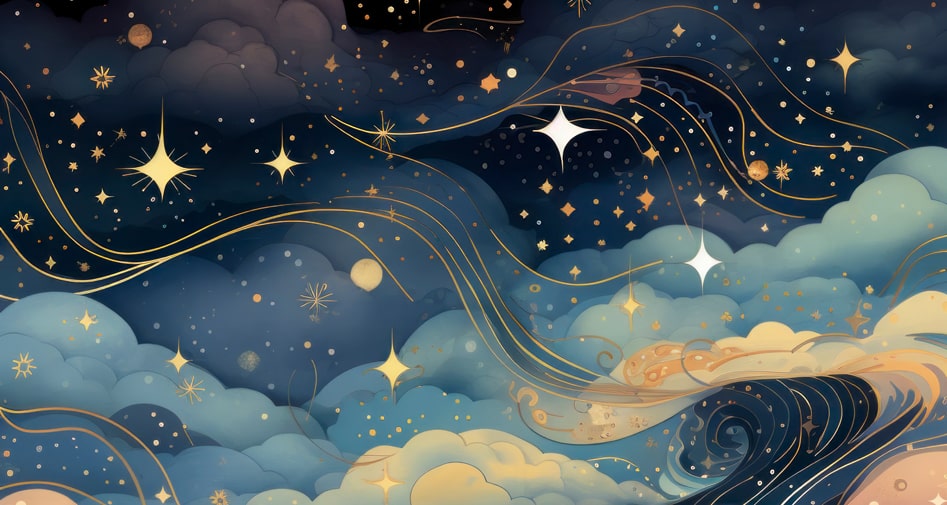
 Facebook
Facebook  Whatsapp
Whatsapp  Messenger
Messenger  Telegram
Telegram Reddit
Reddit
